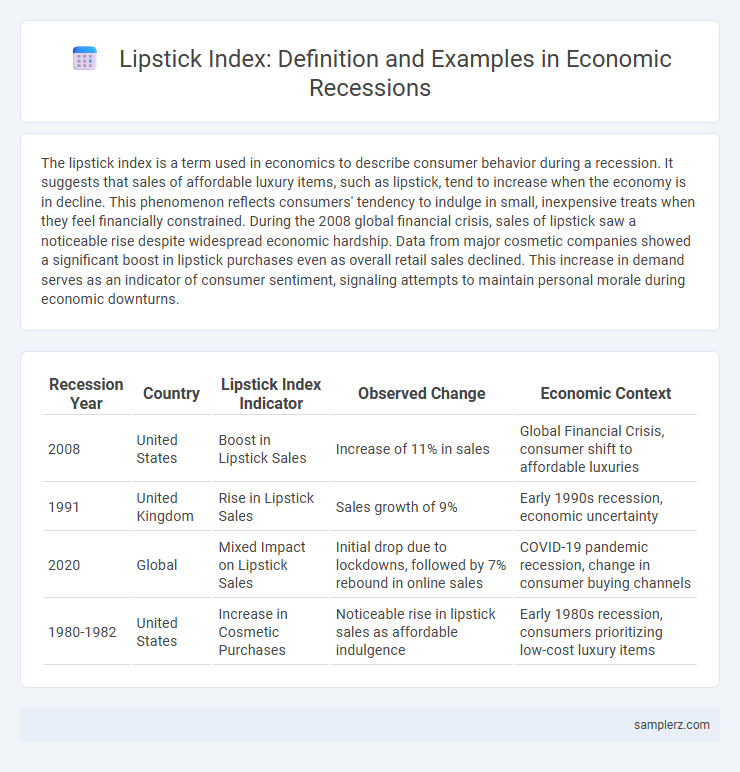The lipstick index is a term used in economics to describe consumer behavior during a recession. It suggests that sales of affordable luxury items, such as lipstick, tend to increase when the economy is in decline. This phenomenon reflects consumers' tendency to indulge in small, inexpensive treats when they feel financially constrained. During the 2008 global financial crisis, sales of lipstick saw a noticeable rise despite widespread economic hardship. Data from major cosmetic companies showed a significant boost in lipstick purchases even as overall retail sales declined. This increase in demand serves as an indicator of consumer sentiment, signaling attempts to maintain personal morale during economic downturns.
Table of Comparison
| Recession Year | Country | Lipstick Index Indicator | Observed Change | Economic Context |
|---|---|---|---|---|
| 2008 | United States | Boost in Lipstick Sales | Increase of 11% in sales | Global Financial Crisis, consumer shift to affordable luxuries |
| 1991 | United Kingdom | Rise in Lipstick Sales | Sales growth of 9% | Early 1990s recession, economic uncertainty |
| 2020 | Global | Mixed Impact on Lipstick Sales | Initial drop due to lockdowns, followed by 7% rebound in online sales | COVID-19 pandemic recession, change in consumer buying channels |
| 1980-1982 | United States | Increase in Cosmetic Purchases | Noticeable rise in lipstick sales as affordable indulgence | Early 1980s recession, consumers prioritizing low-cost luxury items |
Understanding the Lipstick Index Phenomenon in Economic Downturns
The Lipstick Index phenomenon illustrates consumer behavior where sales of small luxury goods, like lipsticks, increase during economic downturns despite overall market contraction. This trend suggests that consumers seek affordable indulgences to boost morale when facing financial uncertainty, making lipstick sales a proxy indicator of recession sentiment. Analyzing retail data during past recessions, including the 2008 financial crisis, reveals consistent spikes in lipstick purchases, highlighting its role as a psychological coping mechanism amid economic stress.
Historical Examples of the Lipstick Index During Recessions
During the early 2000s recession, the Lipstick Index indicated increased sales of affordable luxury items like Chanel lipstick, reflecting consumer preference for small indulgences amid economic uncertainty. Similarly, during the 2008 financial crisis, cosmetic companies reported a rise in lipstick sales despite widespread budget cuts, reinforcing the trend that consumers shift to less expensive luxuries when discretionary spending tightens. These historical instances underscore how the Lipstick Index serves as a barometer for consumer confidence and spending behavior during economic downturns.
How Cosmetics Sales Defy Recession Trends
Cosmetics sales often defy recession trends, exemplified by the Lipstick Index, which observes increased lipstick purchases during economic downturns as consumers seek affordable luxury to boost morale. During the 2008 financial crisis, lipstick sales surged even as overall retail spending declined, indicating a shift in consumer behavior toward smaller indulgences. This pattern highlights the resilience of cosmetic products as counter-cyclical commodities that maintain demand despite broader economic contractions.
The Lipstick Index: Case Studies from Past Economic Crises
During the 2008 financial crisis, sales of affordable luxury items like lipstick surged as consumers sought small indulgences despite tightening budgets, illustrating the Lipstick Index phenomenon. In the 1990s recession, cosmetic companies reported increased lipstick sales even as overall discretionary spending declined, reinforcing the trend. These case studies demonstrate how lipstick purchases can serve as a countercyclical economic indicator, reflecting consumer sentiment during downturns.
Shifts in Luxury Spending: Lipstick as an Affordable Indulgence
During economic downturns, consumers often shift luxury spending toward affordable indulgences, exemplified by the lipstick index, where sales of small luxury items like lipstick increase despite overall market decline. This behavior reflects a psychological need for self-reward and confidence-boosting purchases that remain accessible amidst financial constraints. The lipstick index thus serves as a key indicator of consumer sentiment and discretionary spending patterns during recessions.
Consumer Behavior: Beauty Purchases in Tough Economic Times
During economic recessions, the Lipstick Index reveals that consumers often maintain or increase spending on affordable luxury beauty products like lipsticks despite broader financial constraints. This behavior indicates a psychological coping mechanism where small indulgences provide comfort and a sense of normalcy amidst economic uncertainty. Tracking lipstick sales offers valuable insights into consumer confidence and discretionary spending patterns during downturns.
Comparing Lipstick Index to Other Recession Signals
The Lipstick Index reflects increased lipstick sales during economic downturns, contrasting with traditional recession signals like rising unemployment rates and declining GDP growth. Unlike broad economic indicators, the Lipstick Index captures consumer behavior shifts in affordable luxury goods, offering a unique microeconomic perspective on market sentiment. Comparing these measures enhances recession forecasting by integrating both macroeconomic data and subtle consumer spending patterns.
Lipstick Brands That Thrived in Recessions
During economic downturns, lipstick brands such as Revlon and Estee Lauder experienced increased sales, exemplifying the Lipstick Index phenomenon. Consumers often turn to affordable luxury goods like lipstick to boost morale, driving demand despite broader financial hardship. This trend highlights how resilient beauty brands can capitalize on shifts in consumer behavior during recessions.
Societal Insights: What the Lipstick Index Reveals About Resilience
The Lipstick Index reveals societal resilience by highlighting increased consumer spending on affordable luxury items like lipstick during economic recessions. This trend indicates a psychological boost as individuals seek small indulgences to maintain self-esteem despite financial constraints. Such behavior reflects adaptive coping mechanisms, underscoring the complex relationship between consumer confidence and economic downturns.
Lessons for Investors: Navigating Recession with the Lipstick Index
During recessions, the Lipstick Index reveals that increased sales of affordable luxury items like lipsticks signal consumer confidence amid economic stress, offering investors a nuanced gauge of market sentiment. Monitoring shifts in discretionary spending patterns helps investors identify resilient sectors and adapt portfolios to changing economic conditions. Understanding these trends enables strategic investment choices that capitalize on subtle consumer behavior signals during downturns.

example of lipstick index in recession Infographic
 samplerz.com
samplerz.com